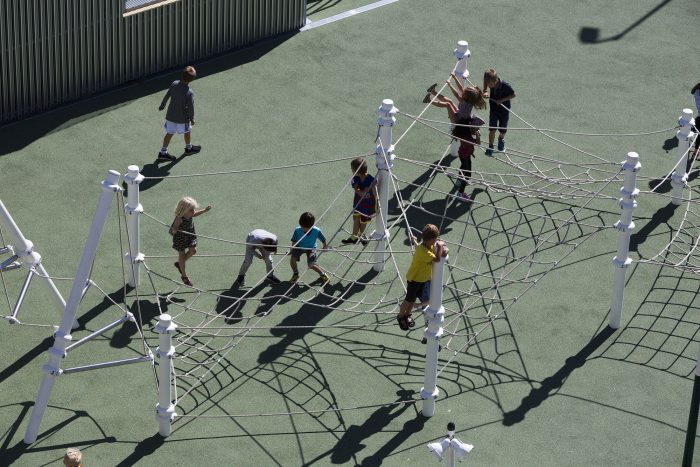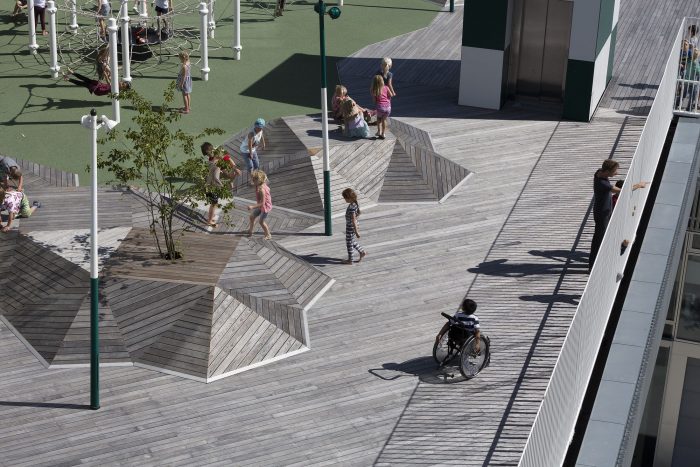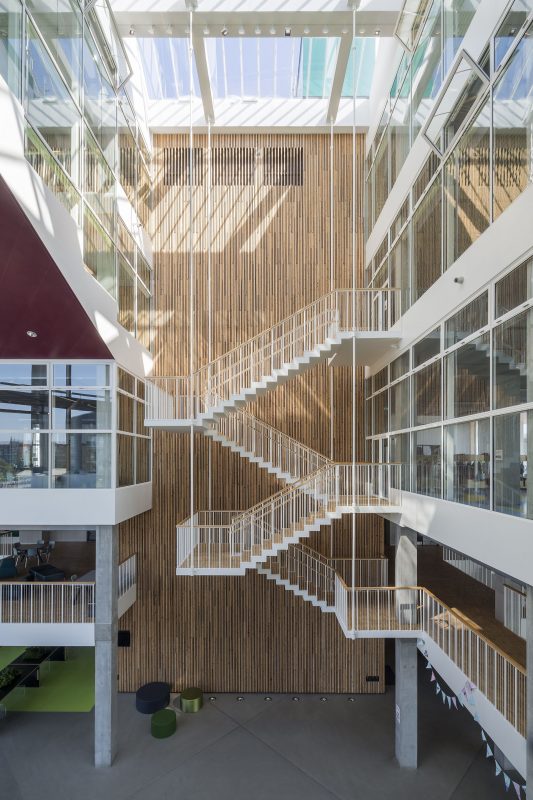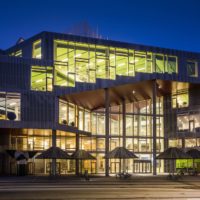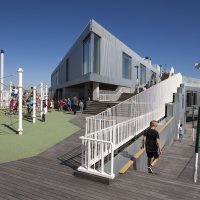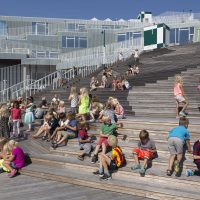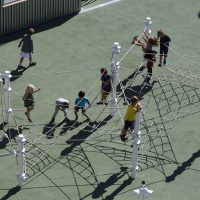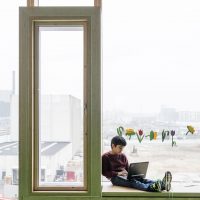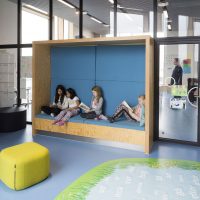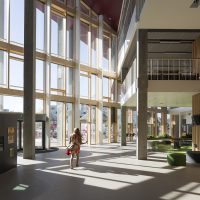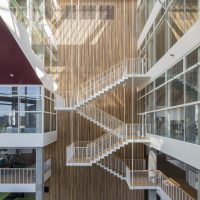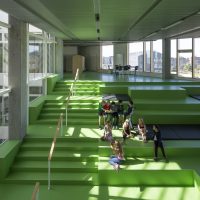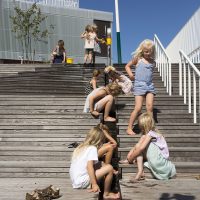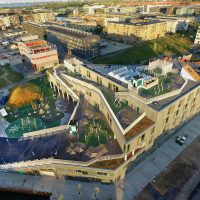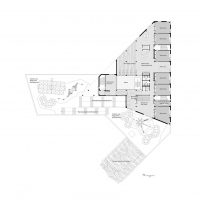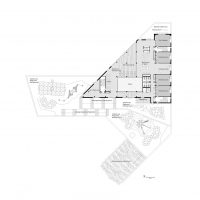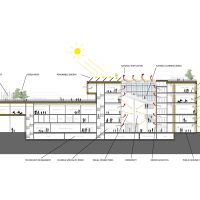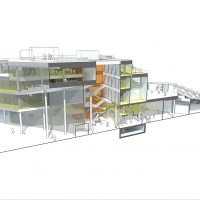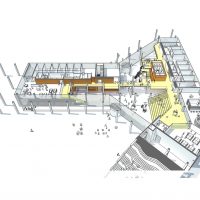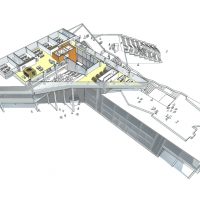South Harbour School
South Harbour School is The Municipality of Copenhagen’s new public school with a maritime and science profile. The School invites its neighborhood in and reaches out to the city. It’s more than a school: It’s an active and socially sustainable part of its community. Located in Copenhagen, Denmark where the population is currently growing at a fast pace of over 1,000 new citizens a month, the city needed to look at increasing its school facilities. The result is South Harbour School. South Harbour School is designed to pursue a vision of schools as spaces for learning and social development. Hence surprises and new experiences are central concepts for the school. On each floor, plan layout changes, and the heights of the floors vary throughout. The concept of social space addresses everything from an overall school community to group assemblies to one-on-one meetings between classmates. This results in tailor-made meeting places that accommodate the specific needs and abilities of the students.
South Harbour School is designed to pursue a vision of schools as spaces for learning and social development. Hence surprises and new experiences are central concepts for the school. On each floor, plan layout changes, and the heights of the floors vary throughout. The concept of social space addresses everything from an overall school community to group assemblies to one-on-one meetings between classmates. This results in tailor-made meeting places that accommodate the specific needs and abilities of the students. It is a partly age-divided school with the junior classes at the bottom, while the upper floors, that house the older pupils, are prepared for age-division as well as age-integration. This way the internal and external spaces take into account what pupils at different stages of their lives are capable of handling and what makes them feel at home and safe. In order to provide a safe environment for the younger children, the smaller classes have their own home area with small clusters that are separated from the other pupils.
It is a partly age-divided school with the junior classes at the bottom, while the upper floors, that house the older pupils, are prepared for age-division as well as age-integration. This way the internal and external spaces take into account what pupils at different stages of their lives are capable of handling and what makes them feel at home and safe. In order to provide a safe environment for the younger children, the smaller classes have their own home area with small clusters that are separated from the other pupils.
 Their home area is located at the heart of the school in connection with indoor and outdoor facilities and underpin the more restricted movement radius. The older pupils share a large, age-integrated home area spread over two floors where the pupils become part of a larger community across age differences – these areas can easily be adjusted to become age differentiated.
Their home area is located at the heart of the school in connection with indoor and outdoor facilities and underpin the more restricted movement radius. The older pupils share a large, age-integrated home area spread over two floors where the pupils become part of a larger community across age differences – these areas can easily be adjusted to become age differentiated. Three large staircases support the different functions: The large staircase towards the water connects the school and the city, the staircase in the atrium gathers the whole school, while the smaller staircase functions as a meeting place for the 4th – 9th graders.
Three large staircases support the different functions: The large staircase towards the water connects the school and the city, the staircase in the atrium gathers the whole school, while the smaller staircase functions as a meeting place for the 4th – 9th graders. The large staircase makes the water an extra classroom: In gymnastics, pupils sail out in canoes and catch a fish that they study in science class and afterward might prepare in cooking class. The space underneath the large staircase is a craft classroom, where the close connection to the waterfront makes it possible to take boats in and repair them as part of woodwork or crafts education classes.
The large staircase makes the water an extra classroom: In gymnastics, pupils sail out in canoes and catch a fish that they study in science class and afterward might prepare in cooking class. The space underneath the large staircase is a craft classroom, where the close connection to the waterfront makes it possible to take boats in and repair them as part of woodwork or crafts education classes.
 The landscape at South Harbour School is designed out of respect for the pupils: Studies show that pupils learn more if they are physically active during the day. Easy access to outdoor areas and spaces for physical activities is a, therefore, a fundamental part of the project. When we design schools, we feel it is our duty to provide the best possible physical frames for learning and social development – but also help pupils with healthy habits from an early age.
The landscape at South Harbour School is designed out of respect for the pupils: Studies show that pupils learn more if they are physically active during the day. Easy access to outdoor areas and spaces for physical activities is a, therefore, a fundamental part of the project. When we design schools, we feel it is our duty to provide the best possible physical frames for learning and social development – but also help pupils with healthy habits from an early age. The landscape at South harbor School supplies them with an alternative/or addition to their physically inactive lives – an alternative where the use of the body and a tactile engagement becomes a natural part of their daily lives. All roofs are activated, they enhance movement, play, and sports. This way the landscape nudges pupils to be active and orchestrate meetings with their fellow students during the day.
The landscape at South harbor School supplies them with an alternative/or addition to their physically inactive lives – an alternative where the use of the body and a tactile engagement becomes a natural part of their daily lives. All roofs are activated, they enhance movement, play, and sports. This way the landscape nudges pupils to be active and orchestrate meetings with their fellow students during the day. In sustainable terms, the South Harbour School follows the parameters in the DGNB-approach. The use of the school building after school hours extends the sustainable approach that is furthermore underpinned by the incorporation of solar panels and the chosen isolation materials. A major part of the sustainable approach is the social aspect of the project. The outdoor areas are more than traditional schoolyards – they are part of a green ledge that is stretched throughout most of the Sydhavnen. Rather than isolating the school, it is opened up and the green ledge is extended so that the schoolyard functions as a public park.
In sustainable terms, the South Harbour School follows the parameters in the DGNB-approach. The use of the school building after school hours extends the sustainable approach that is furthermore underpinned by the incorporation of solar panels and the chosen isolation materials. A major part of the sustainable approach is the social aspect of the project. The outdoor areas are more than traditional schoolyards – they are part of a green ledge that is stretched throughout most of the Sydhavnen. Rather than isolating the school, it is opened up and the green ledge is extended so that the schoolyard functions as a public park.
 Project Info
Project Info
Architects: JJW Architects
Location: Copenhagen, Denmark
Size: 100,000 sqft – 300,000 sqft
Client: Municipality Of Copenhagen
Engineer: Niras
Landscape Architects: PK3 Landskab, JJW Landscape
Contractors: Jakon, B. Nygaard Sorensen A/S, Lindpro, GVL Enterprise
Project Managers: Friis Andersen Arkitekter
Consultants: Keinicke & Overgaard Arkitekter, Peter Holst Henckel
Year: 2015
Type: Educational
Photographs: Torben Eskerod, Courtesy of JJW Architects
- photography by © Torben Eskerod
- photography by © Torben Eskerod
- photography by © Torben Eskerod
- photography by © Torben Eskerod
- photography by © Torben Eskerod
- photography by © Torben Eskerod
- photography by © Torben Eskerod
- photography by © Torben Eskerod
- photography by © Torben Eskerod
- photography by © Torben Eskerod
- photography by © Torben Eskerod
- photography by © Torben Eskerod
- photography by © Torben Eskerod
- photography by © JJW Arkitekter
- Plan 1 Floor
- Plan 2nd Floor
- Plan 3rd Floor
- Plan 4th Floor
- Plan 1/1000
- Sustentability
- Diagram
- Diagram
- Diagram


